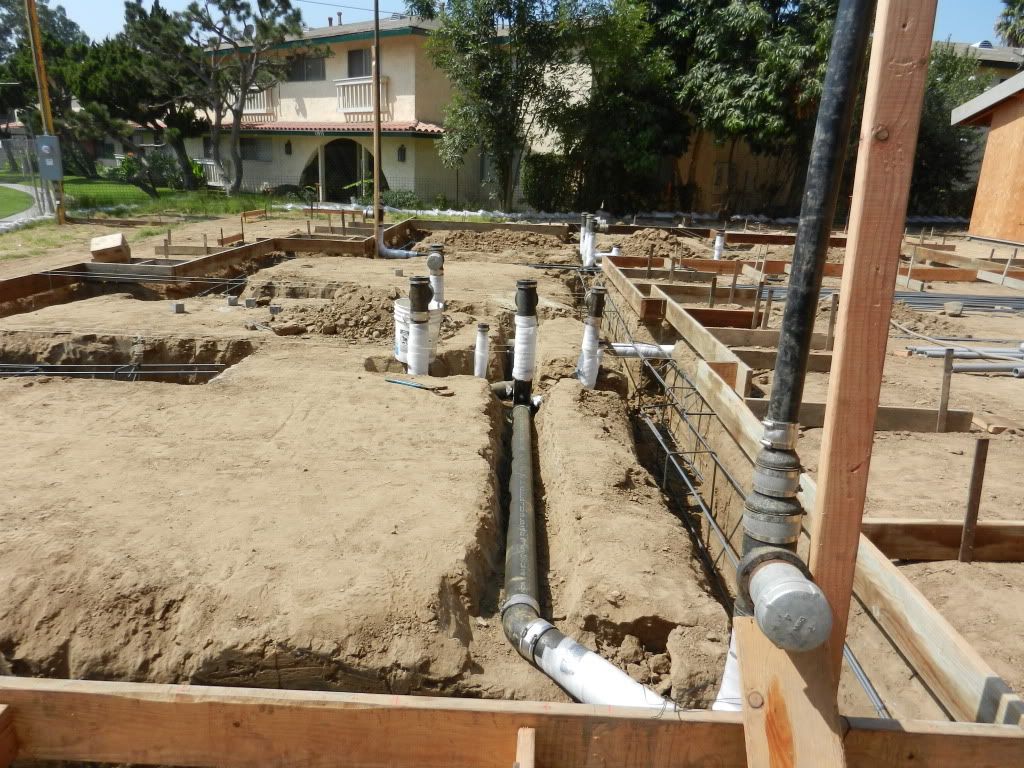enough until you realize that it is all 4" dia. pipe. The second picture is the drain pipe for a kitchen sink.




Your premier resource for building code knowledge.
This forum remains free to the public thanks to the generous support of our Sawhorse Members and Corporate Sponsors. Their contributions help keep this community thriving and accessible.
Want enhanced access to expert discussions and exclusive features? Learn more about the benefits here.
Ready to upgrade? Log in and upgrade now.


If the pipe passes through the footing it gets an arch or a sleeve. So I'm going by memory here, but a sleeve must be two sizes bigger that the pipe and the annular space shall be sealed. If a pipe is used as the sleeve, what should be used to seal the annular space?north star said:* * * *They CAN still go above the code and install the 4" dia. pipe
can't they?.......Also, do they use pipe sleeves or relieving
arches out there, in the perimeter footings?....[ refer to
P2603.5, `06 IRC ].
* * * *
It seems to me that I remember the UPC used to say that a horizontal waste pipe can't be more than two sizes larger than the required size. The scouring action is negated when there is a dribble in a big pipe. It runs straight down the center without sloshing back and forth. There was also something about excessive pitch for the same reason. There's more to being a plumber than smelling good. There is a sweet spot for running sh!t down a pipe.Builder Bob said:They can, but might not be a great idea...... the water flow drastically slows down for the same volume of water/wastes when pipe is upsized. Could create more opportunities for blockage and back-up in plumbing pipes because more water is needed to keep pushing the crap downstream...
Yes it is.RJJ said:Is the cast iron pipe no hub?
A material that is approved by the AHJ."If a pipe is used as the sleeve, what should be used to seal the annular space?"
I agree!......Also, the use of "low flow" type water closets will not facilitate thescouring and transportation process when the larger sized piping is used."It seems to me that I remember the UPC used to say that a horizontalwaste pipe can't be more<BR>than two sizes larger than the required size.
The scouring action is negated when there is a dribble in a big pipe. It runs
straight down the center without sloshing back and forth. There was also something
about excessive pitch for the same reason. There's more to being a plumber
than smelling good. There is a sweet spot for running sh!t down a pipe."
I would not recommend the use of foam wrapping as it does not / will not provide"what do you think of this method? Wrap the pipe with foam as thick as three pipe sizes and it's done.Is the foam too dense to collapse if there is settlement?"
As " Papio " has recently referenced, by using the god section of the IRC......From Section R104.11of the `06 IRC: Alternative materials, design and methods of construction and equipment."I don't find any specific code requirement prohibiting the larger drain lines. I agree largermay not be better in a building drainage system but how do you back it up with the code?"
Because of the "low flow" type water closets, there is not enough water [ themedium of transportation ] to deliver the solids to the point of connection"How is it an alternate when a maximum drain size is not limited?"
Fail. There were a few flat spots. Bands needed to be tightened. Nothing major. By the way, the waste pipe has to pass inspection before I allow the wrap and this picture was taken between under-floor plumbing and footing inspections. When I do the footing/slab inspection I expect the pipe that will be in contact with concrete to be well protected and that means no black and white bands as you see here.north star said:Sooooooo, ...was this installation a PASS or FAIL?
[/font][/size][/color]& & & &
